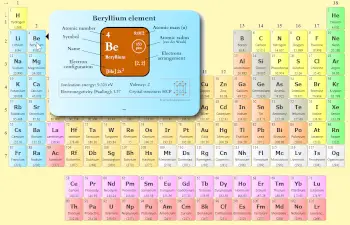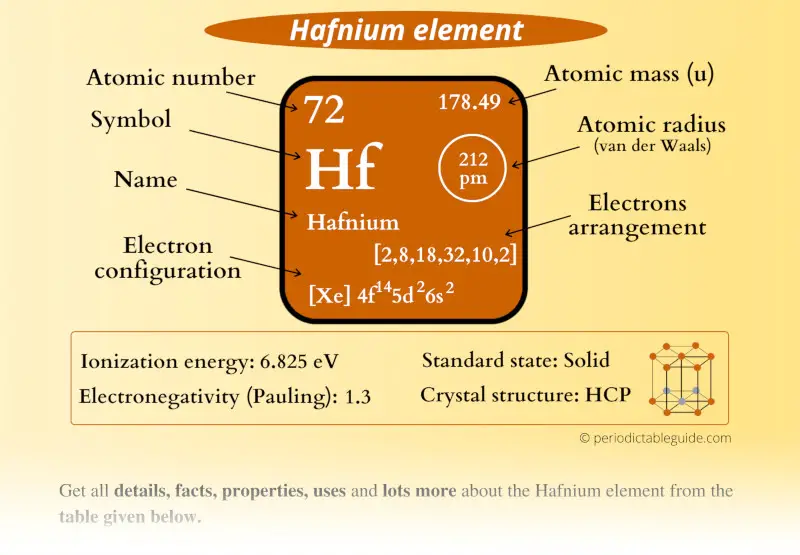
This is a SUPER easy guide on Hafnium element.
In fact, the table mentioned below is the perfect information box (Which gives you every single detail about the Hafnium element in Periodic table.)
So if you want to know anything about Hafnium element, then this guide is for you.
Let’s dive right into it!
Hafnium Element (Hf) Information
| Appearance |  Metallic gray |
| State at STP | Solid |
| Position in Periodic table |  Group: 4, Period: 6, Block: d |
| Category | 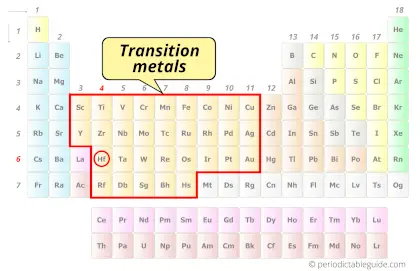 Transition metals |
| Atomic number or Protons | 72 |
| Neutrons | 106 |
| Electrons | 72 |
| Symbol | Hf |
| Atomic mass | 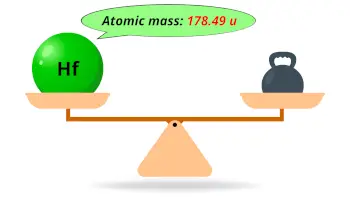 178.49 u |
| Electrons arrangement or Bohr model | 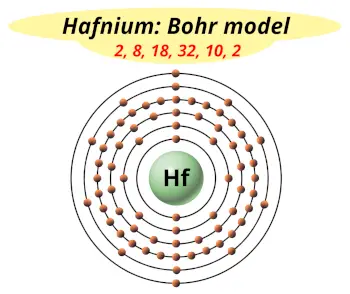 2, 8, 18, 32, 10, 2 |
| Electronic configuration | [Xe] 4f14 5d2 6s2 |
| Atomic radius | 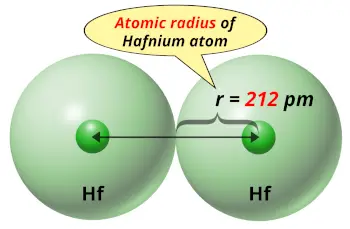 212 picometers (van der Waals radius) |
| 1st Ionization energy | 6.825 eV |
| Electronegativity | 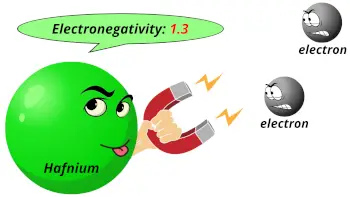 1.3 (Pauling scale) |
| Crystal structure | 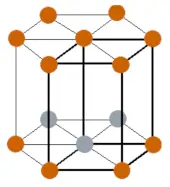 HCP (Hexagonal close packed) |
| Melting point | 2506 K or 2233 °C or 4051 °F |
| Boiling point | 4876 K or 4603 °C or 8317 °F |
| Density | 13.31 g/cm3 |
| Main isotope | 180Hf |
| Who discovered Hafnium and when? |  George de Hevesy and Dirk Coster (in 1922) |
| CAS number | 7440-58-6 |
Hafnium in Periodic table
Hafnium element is in group 4 and period 6 of the Periodic table. Hafnium is the d-block element and it belongs to transition metals group.
| H | He | ||||||||||||||||
| Li | Be | B | C | N | O | F | Ne | ||||||||||
| Na | Mg | Al | Si | P | S | Cl | Ar | ||||||||||
| K | Ca | Sc | Ti | V | Cr | Mn | Fe | Co | Ni | Cu | Zn | Ga | Ge | As | Se | Br | Kr |
| Rb | Sr | Y | Zr | Nb | Mo | Tc | Ru | Rh | Pd | Ag | Cd | In | Sn | Sb | Te | I | Xe |
| Cs | Ba | La* | Hf | Ta | W | Re | Os | Ir | Pt | Au | Hg | Tl | Pb | Bi | Po | At | Rn |
| Fr | Ra | Ac** | Rf | Db | Sg | Bh | Hs | Mt | Ds | Rg | Cn | Nh | Fl | Mc | Lv | Ts | Og |
| *Ce | Pr | Nd | Pm | Sm | Eu | Gd | Tb | Dy | Ho | Er | Tm | Yb | Lu | ||||
| **Th | Pa | U | Np | Pu | Am | Cm | Bk | Cf | Es | Fm | Md | No | Lr |
←Move to: Lanthanum (La) element – Periodic Table
→Move to: Tantalum (Ta) element – Periodic Table
Why is Hafnium in Period 6?
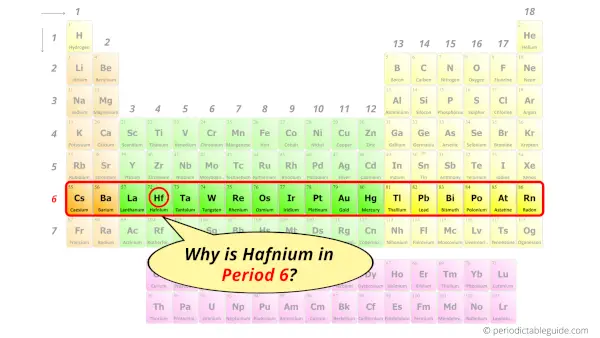
Let me ask you a question.
How many shells does hafnium atom have?
It’s 6. Right?
You have already seen the bohr model of hafnium atom in the above table.
From the Bohr model, it can be found that the number of orbits or shells in hafnium is 6. Hence, as hafnium has 6 orbits, it lies in period 6 of the Periodic table.
Why is Hafnium in d-block?
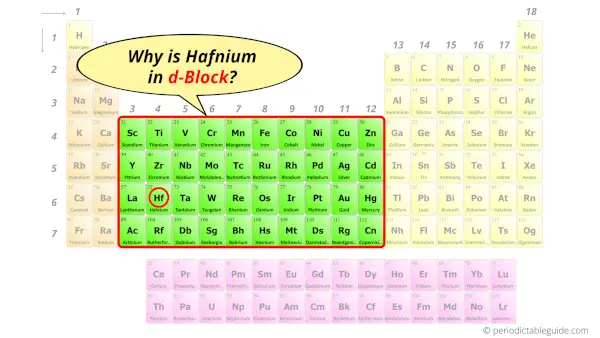
Before knowing this reason, first of all I want to ask you a simple question.
How can you determine the blocks-wise position of elements?
The simple answer: The elements will lie in the s, p, d or f block will completely depend upon the subshell in which the last electron will enter.
For example; the electron configuration of hafnium is [Xe] 4f14 5d2 6s2.
So the last electron of hafnium enters the d-subshell or d-orbital.
Hence, hafnium is the d-block element.
Is Hafnium a Transition Metal? Why?
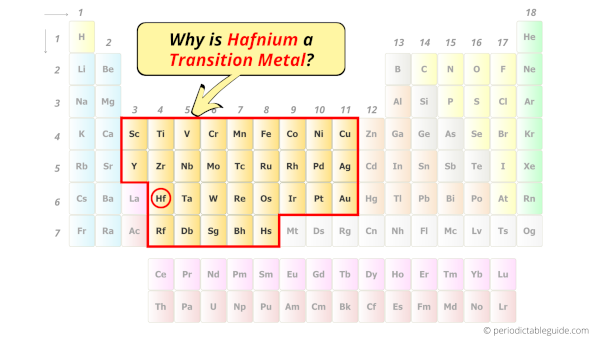
Yes, Hafnium is a transition metal because it has incompletely filled d-orbital in its ground state.
Let me explain the exact meaning of this.
According to the definition of transition metals;
The element should compulsorily have incomplete d-orbitals, either in their ground state (M) or most common oxidation states (M1+, M2+, etc) then only they are called transition metals.
Now, the ground state of Hafnium means its normal state in which it has neither gained nor lost any electron/s.
So the ground state of Hafnium is Hf.
And the ground state electronic configuration of Hafnium is [Xe] 4f14 5d2 6s2.
In this state, if we see the electron configuration of Hafnium, then it possesses incomplete d-orbitals.

Because, there are only two electrons in the d-orbitals (here 5d orbitals).
In order to have the complete d-orbitals, there must be 10 electrons in it.
But in the ground state electronic configuration of hafnium, you can see that it has only 2 electrons in d-orbitals.
Thus, Hafnium has incomplete d-orbitals.
And hence, as Hafnium has incomplete d-orbitals, it is considered as a transition metal.
5 Interesting facts about Hafnium
Interesting facts about hafnium element are mentioned below.
- The name “Hafnium” was derived from the latin word “Hafnia” which means “Copenhagen”. (Copenhagen is a city in Denmark).
- Hafnium was discovered by George de Hevesy and Dirk Coster (in 1922).
- The concentration of hafnium in earth’s crust is approximately 3.3 ppm by weight.
- Hafnium is not found free in nature, but it is always found as a compound with other elements.
- Hafnium is generally produced as a byproduct while refining zirconium.
Properties of Hafnium
The physical and chemical properties of hafnium element are mentioned below.
Physical properties of Hafnium
Physical properties of hafnium are mentioned below.
- Hafnium is a solid metal having a metallic grey appearance.
- The atomic mass of hafnium is 178.49 u and its density is 13.31 g/cm3.
- The melting point of hafnium is 2233 °C and its boiling point is 4603 °C.
- The hafnium element has a crystal structure of HCP (Hexagonal close packed).
- Hafnium has many isotopes, but out of those isotopes, the most abundant isotope is 180Hf (having abundance of approximately 35 %).
Chemical properties of Hafnium
Chemical properties of hafnium are mentioned below.
- Hafnium does not react with alkalis as well as acids (except hydrogen fluoride).
- Hafnium is a transition metal and hence it shows multiple oxidation states. But in its compound states, it is mostly present in +4 oxidation state.
- When hafnium reacts with halogens (like fluorine, chlorine, bromine, etc.), it forms tetrahalides.
- Hafnium also reacts with elements like boron, carbon, oxygen, nitrogen, sulfur and silicon at higher temperatures.
Uses of Hafnium
Uses of hafnium are mentioned below.
- Hafnium has a property to absorb neutrons, and hence it is used in control rods in nuclear reactors.
- Hafnium is also used as an alloying element with other metals like iron, titanium, niobium, etc to get the improved properties.
- When hafnium is alloyed with carbide, it gives an alloy that is resistant to higher temperature. This hafnium carbide is used in metal melting furnaces.
Free Gift for you: Interactive Periodic Table
Let me tell you how this Interactive Periodic Table will help you in your studies.
1). You can effortlessly find every single detail about the elements from this single Interactive Periodic table.
2). You will get the detailed information about the periodic table which will convert a newbie into pro.
3). You will also get the HD images of the Periodic table (for FREE).
Checkout Interactive Periodic table and download it’s high resolution image now (It’s FREE)
External resources:
- Hafnium – Element information, properties and uses | Periodic Table. (n.d.). Hafnium – Element Information, Properties and Uses | Periodic Table. https://www.rsc.org/periodic-table/element/72/hafnium
- Hafnium – Wikipedia. (2021, November 12). Hafnium – Wikipedia. https://en.wikipedia.org/wiki/Hafnium
- It’s Elemental – The Element Hafnium. (n.d.). It’s Elemental – the Element Hafnium. https://education.jlab.org/itselemental/ele072.html
- P. (n.d.). Hafnium | Hf (Element) – PubChem. Hafnium | Hf (Element) – PubChem. https://pubchem.ncbi.nlm.nih.gov/element/Hafnium
